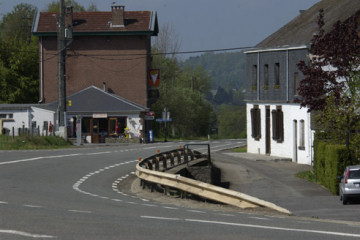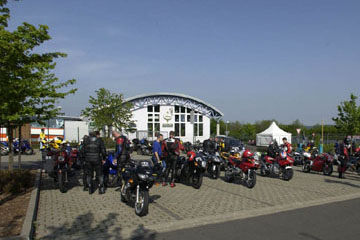Touring Spa and the Nurburgring
by Gordon Kirbyillustrated by Paul Webb

The Masta Kink
We arrived at Spa in the middle of Belgium's Ardennes forest the night after the Brands Hatch race. It was misty and drizzling, typical Ardennes weather, and we slept happily after an excellent dinner. To my surprise, the following morning dawned bright and sunny and we were able to investigate the original Spa circuit in the best possible conditions.
The original track comprised public roads and was opened in 1925. In its earliest form through the start of World War 2 the track was more than nine miles long. In contrast to modern times, the track was made faster rather than slower by opening up some corners. In 1939 the hairpin after Eau Rouge was removed and eighteen years later the Stavelot hairpin was also bypassed, pushing lap speeds over 130 mph. By 1967 when Dan Gurney drove his AAR Eagle-Weslake V12 to victory at Spa to become the only American ever to win a Grand Prix in his own, American-built car, Gurney, Jim Clark and Graham Hill were able to lap the track at more 150 mph--a phenomenal achievement.
Unfortunately, the current four-mile track was closed for private testing the day we were there. That meant we were unable to take a look at the pits or Eau Rouge. Instead we drove through the outskirts of town to pick up the old circuit at Les Combes.
In town there were banners and posters urging people to join the effort to, "Save our Grand Prix". A dispute over European tobacco advertising laws resulted in the cancellation of this year's Belgian GP and led to rumors that Spa might run a Champ Car race instead.
That possibility now seems extremely unlikely however and Bernie Ecclestone recently said that F1 will return to Spa next year. If F1 doesn't return it would obviously be great to see the Champ Car World Series race at Spa. We can only hope!
The public roads in that part of Belgium are nothing short of superb--smooth, wide and well-maintained. They're perfect roads to turn into a racetrack and all I can say is the original Spa layout blew my mind. Talk about a real man's race track filled with diving or climbing high-speed corners. This was it, truly humbling compared to so much of what we see today.
You can pick up the old track a little less than halfway around the modern circuit. After the climb from Eau Rouge the track used to proceed to Les Combes a very fast left turn over the brow of a hill. From Les Combes the road dives downhill, then begins turning to the right through the village of Burneville. The corner goes on and on, diving all the way to Malmedy where there is now an intersection.
 Malmedy was a flat-out kink to the right and it was here that Jackie Stewart crashed on the opening lap of the infamous 1966 Belgian GP, run in pouring rain. Stewart broke a shoulder and rib in the accident and had to be pulled from his car by teammate Graham Hill who also crashed at the same spot. Seven cars crashed in two multiple accidents on the first lap in '66 and those accidents led to a sharply increased safety campaign led by Stewart. By 1970 the original Spa had seen its last F1 race.
Malmedy was a flat-out kink to the right and it was here that Jackie Stewart crashed on the opening lap of the infamous 1966 Belgian GP, run in pouring rain. Stewart broke a shoulder and rib in the accident and had to be pulled from his car by teammate Graham Hill who also crashed at the same spot. Seven cars crashed in two multiple accidents on the first lap in '66 and those accidents led to a sharply increased safety campaign led by Stewart. By 1970 the original Spa had seen its last F1 race.
Exiting Malmedy the road flattens out on the approach to the legendary Masta kink. The best drivers were able to get through Masta without lifting and the place is truly intimidating with two white brick houses forming the apexes on either side of the road. A tiny mistake there and you were history. Gurney and the other greats who were able to get through Masta flat-out were able to pull out a hundred or more yards on anyone they were racing.
Out of Masta the road carries on into Stavelot, another blindingly fast turn. The road begins to climb through Stavelot, turning uphill to the right. Stavelot starts fairly tight, then opens up and it's difficult to imagine the speed that a Clark or Gurney would have gathered entering Stavelot.
From there the road climbs uphill through a series of flat-out kinks. This part of the road is now quite rough and almost disused as it rises through Blanchimont to rejoin the new track. After completing a lap we drove back to Les Combes to take it all in one more time and I would strongly recommend such an excursion to anyone who finds themselves in southern Belgium. A trip around Spa-Francorchamps will provide you with an even deeper appreciation for the great drivers of the fifties and sixties and the titans of the pre-WWII era.
From Spa it's a short drive, barely an hour, through the Ardennes into Germany and the Eifel mountains to The 'Ring. It's fine countryside with great rolling hills, forests and fields and perfectly clean, pristine towns and villages. Like in Belgium, the roads in that part of Germany are generally in excellent condition.
The Nurburgring was opened in 1927 of course, a product of the government's job creation program in those bleak times. The first three German GPs held at the magnificent new track were run on the old 17.5-mile combined circuit including both the Nordschleife and the Sudschleife but in 1931 the race settled down on the 14-mile, 176-turn Nordshcliefe.
It was home to the German GP through Niki Lauda's fiery 1976 accident which underlined the fact that sport had outgrown the great track. There were too many trees, too few barriers, too little run-off room and it was too long to be properly serviced by modern medical teams. The 'Ring was replaced by Hockenheim and a new government-funded modern 2.8-mile GP circuit was eventually built on the site of the old Sudschleife.
 Today's Nurburgring is a very professional, commercially-minded place. There's a hotel on the start/finish straight and the old track is in constant use, leased by car and motorcycle manufacturers and clubs. At the end of each day a 12-mile segment of the Nordschleife is open to the public. For fourteen Euros you can take a lap of the track in your car on on your motorcycle and when we arrived to run our laps there were literally hundreds of motorcyclists ahead of us.
Today's Nurburgring is a very professional, commercially-minded place. There's a hotel on the start/finish straight and the old track is in constant use, leased by car and motorcycle manufacturers and clubs. At the end of each day a 12-mile segment of the Nordschleife is open to the public. For fourteen Euros you can take a lap of the track in your car on on your motorcycle and when we arrived to run our laps there were literally hundreds of motorcyclists ahead of us.
Many of the two-wheelers are pretty serious and know the track well so if you're driving a standard rental car you have to keep a sharp eye in your mirrors to make way for the bikers when they come through, usually in swarms of five or six. The fastest rider we saw was the only guy with a passenger! She was either crazy or madly in love with the fellow.
Driving The 'Ring is a magnificent experience. Outdated it may be but it remains a beautiful track in great condition. The surface, curbs and guardrail are first class for indeed touring and sports car racing still takes place there. After my first taste of it this year, I've decided I've got to sample the place sometime in the future at the wheel of more of a high-performance car than we enjoyed this time 'round.
Whenever you're in Europe you should make time in your schedule to visit Spa and the Nurburgring. It will give you a fine taste that you'll always savor of what the sport used to be about.
Auto Racing ~ Gordon Kirby & Paul Webb ~ Words and Images
Copyright 2006 ~ All Rights Reserved
Copyright 2006 ~ All Rights Reserved
Top of Page